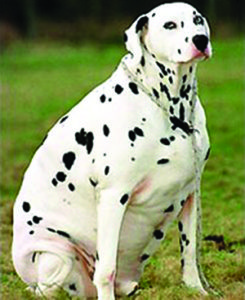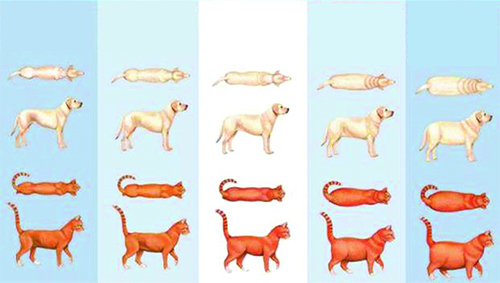OBESITY – Killing Our Pets With Kindness
By Chad Bower, DVM
Obesity is an increasing health concern for dogs and cats. Just as in people, being overweight contributes to a large number of diseases in pets. The problem can be metabolic, such as with hypothyroidism, but most often is a result of one problem: more calories eaten than expended throughout the day. Indoor pets are especially at risk for being overweight because of reduced activity. Recent surveys indicate that over 50 percent of the American pet population is overweight or obese.
When an animal consumes any type of food, it is broken down into simple sugars in the digestive tract. These simple sugars are readily available to provide instant energy to cells and organs. Extra energy (glucose) that is not needed by the body is converted by the liver into fat to be utilized when food is scarce. The problem in house pets is that food is never scarce. No one likes to see their beloved pet go hungry. Fat is continually accumulated which begins to cause problems elsewhere in the body.
 Some connections between obesity and disease are easy to realize. Joints can be over-burdened by carrying too much weight and develop arthritis or the excess weight can contribute to ligament ruptures. Other obesity related problems are less obvious, but equally as devastating. Excess body fat can contribute to becoming diabetic. Diabetes is a serious disease that causes blood sugar levels to soar uncontrollably leading to all sorts of ill effects. Overweight pets are more susceptible to heat stroke because dogs and cats do not sweat to cool themselves, and the fat acts as an insulating blanket over the body. Respiratory problems and heart disease are caused by and complicated by obesity. Overweight pets are also at increased risk during anesthetic and surgical procedures.Obesity reduces quality of life and shortens lifespan. One Purina study showed that dogs with ideal body conditions live on average 15% longer than obese pets.
Some connections between obesity and disease are easy to realize. Joints can be over-burdened by carrying too much weight and develop arthritis or the excess weight can contribute to ligament ruptures. Other obesity related problems are less obvious, but equally as devastating. Excess body fat can contribute to becoming diabetic. Diabetes is a serious disease that causes blood sugar levels to soar uncontrollably leading to all sorts of ill effects. Overweight pets are more susceptible to heat stroke because dogs and cats do not sweat to cool themselves, and the fat acts as an insulating blanket over the body. Respiratory problems and heart disease are caused by and complicated by obesity. Overweight pets are also at increased risk during anesthetic and surgical procedures.Obesity reduces quality of life and shortens lifespan. One Purina study showed that dogs with ideal body conditions live on average 15% longer than obese pets.
Feeding regimens are the first place to start when addressing obesity. Two or three small meals a day, rather than free-choice feeding (keeping a full bowl), allows the body to utilize calories more efficiently and store less fat. Feeding a balanced, nutritious diet formulated for a dog or a cat of a specific age and activity level is equally important. The amount to feed depends on the metabolism of the individual. Table scraps tend to be high in fats and salt and they are often given in addition to the pet’s regular diet that already contains an adequate number of calories for energy. Also if you are giving treats, be aware that many are high in calories and must also be figured into total food consumption.
The other way to prevent obesity is to increase a pet’s activity levels. This can be difficult with an already obese dog or cat because their stamina may be decreased. They may already suffer from the side effects of being overweight. Consult a veterinarian about how much activity is appropriate for your pet. As weight comes off, you will see a considerable change in the dog or cat’s attitude and energy levels. What was once thought of as an old lazy pet can regain the pep of a young healthy animal. For healthy pets a minimum of 20 minutes of heart pumping exercise daily is recommended.
It is important to not cause weight loss too quickly. Starvation is not the answer to obesity. Cats cannot metabolize fat rapidly without serious ill-effects. Check with your veterinarian to establish an ideal weight and timeline for weight loss. Set goals and commit to regular weigh ins.
Our pets will thank us for helping them maintain an ideal body weight. They will live longer and happier lives as a result. If you have further questions or concerns with your pets weight, health, or need assistance in formulating a weight loss plan please schedule an appointment with your veterinarian.

Healthy Weight
- Ribs are easily felt
- Tucked abdomen – no sagging stomach
- Waist when viewed from above
Ideal body weight for your pet is set by more than just the scale. Body condition scoring (BCS) is employed to gauge your pet’s healthy weight.
